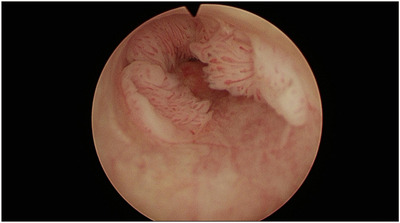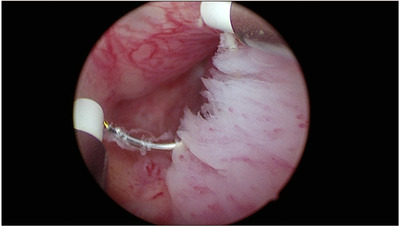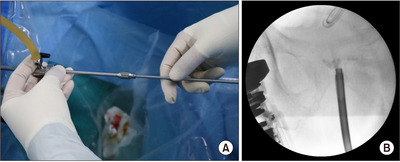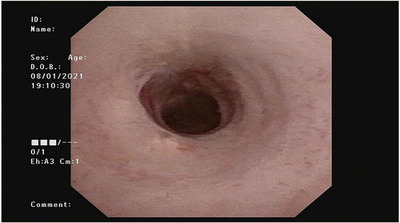Abstract
Condyloma acuminatum is a common sexually transmitted disease caused by the human papillomavirus and with a high recurrence rate in the urethra. We report the intraurethral instillation of 5-fluorouracil cream for intraurethral condyloma acuminatum with suprapubic cystostomy after transurethral surgery. A 64-year-old man had gross hematuria for several days. At cystourethroscopy, multiple papillary mass lesions were identified on the entire urethra. Transurethral resection of the urethral masses confirmed the diagnosis of condyloma acuminatum. However, recurrent multiple warts were identified on the whole urethra. After re-surgery, intraurethral instillation of 5-fluorouracil cream with suprapubic cystostomy was achieved to prevent a recurrence. After one year of 5-fluorouracil instillation, there was no recurrence of intraurethral condyloma acuminatum.
-
Keywords: Condylomata acuminata, Drug instillation, Recurrence, Cystostomy
CASE REPORT
A 64-year-old man with intracerebral hemorrhage consulted the neurosurgery department due to the persistent occurrence of gross hematuria. At cystourethroscopy, the presence of multiple papillary mass lesions was detected from the penile urethra to the prostatic urethra (
Fig. 1). Transurethral resection of the urethral tumor (TURUT) was performed, and CA was confirmed by biopsy (
Fig. 2). However, there was a recurrence of multiple warts extending from the glans to the prostatic urethra three months post-surgery. A re-TURUT was conducted, and the patient also underwent a suprapubic cystostomy due to an underactive bladder. Subsequently, after two weeks of surgery, we planned for intraurethral instillation of 5-FU to prevent the recurrence of intraurethral CA.
In the first cycle, 10 mg of 5-FU was injected into the urethra, using an endoscopic applicator for matrix hemostatic sealant with C-arm (
Fig. 3). After two weeks, the intraurethral instillation of 5-FU was repeated using the same method in the first cycle. No penile clamp was used during the procedure. After three months, the suprapubic cystostomy catheter was removed, and the patient had no complications such as hematuria, dysuria, and voiding symptoms. After six months, a mild stricture of the penile urethra was observed in urethrography, but the flexible cystoscope passed through well. Furthermore, no recurrence of CA was observed throughout the urethra at cystoure-throscopy (
Fig. 4). A follow-up after one year of 5-FU instillation revealed no recurrence of CA or any associated complications.
The study was approved by the Institutional Review Board (IRB) of Yeungnam University Hospital (IRB No: 2022-07- 011), which waived the need for informed consent owing to the retrospective design of the study.
DISCUSSION
CA is a common STD caused by the human papillomavirus. CA typically occurs in the external genitalia, perineum, and perianal skin. It rarely involves the cervical canal, anus, and urethra. With an incidence of up to 12.5%, most intraurethral CA occur in the urethral meatus [
1,
2]. Because of the mucosal immune system, isolated intraurethral CA without external genitalia lesions is a relatively rare occurrence [
3]. Therefore, due to the high rate of recurrence, a combined therapeutic strategy (surgery and medical treatment) is more effective than a single modality [
4].
There are several medical treatments for intraurethral CA, such as 5-FU, antiviral agents, and photodynamic therapy [
4]. However, there are no definite guidelines, and these methods have some limitations due to recurrence and associated complications including hematuria, pain, or stricture. In the current case, we first performed surgical excision by transurethral resection using a bipolar device to rule out urothelial carcinoma. After confirming CA, intraurethral 5-FU instillation was performed after two weeks to prevent the recurrence of CA.
Although the mechanism of 5-FU for intraurethral CA is unclear, the area of 5-FU instillation showed necrosis and the disappearance of CA. Furthermore, other adverse events such as hematuria and stricture rarely occurred with 5-FU instillation. Previous studies have reported various regimens of 5-FU instillation, such as dose, retention time, dosage frequency, and the number of cycles [
5-
8]. In the current study, 10 ml of 5% 5-FU cream was administered to the urethra for a total of twice biweekly intervals. A novel device, an endoscopic hemostatic applicator, was used for even instillation from the prostatic urethra to the urethral meatus to prevent the recurrence of CA. In previous studies, the instillation of 5-FU was performed using a lidocaine syringe [
7,
8]. However, we believed that the lidocaine syringe is inadequate to evenly distribute 5-FU in the entire urethra. Also, since 5-FU is a cream, a small caliber and short-length applicator tip would be inadequate for the even instillation of 5-FU throughout the urethra. Hence, we used a large caliber, long length, and stiff applicator tip as an endoscopic hemostatic applicator to instill 5-FU evenly from the prostatic urethra to the urethral meatus.
Furthermore, our patient underwent a suprapubic cysto-stomy after transurethral resection due to an underactive bladder. In previous studies, the authors used a penile clamp to prevent washing out of the 5-FU by urine stream. However, we thought that a suprapubic cystostomy would be more helpful to prevent the recurrence of CA than a penile clamp, as 5-FU spread on the urethra would be retained for longer. In summary, in our efforts to distribute the drug evenly throughout the urethra, we prevented the recurrence of CA with only two 5-FU applications.
FUNDING
No funding to declare.
NOTES
-
CONFLICT OF INTEREST
No potential conflict of interest relevant to this article was reported.
-
AUTHOR CONTRIBUTIONS
J.G.H. participated in data collection and wrote the manuscript. J.G.H., Y.H.K., and Y.U.K. participated in the study design and performed the statistical analysis. Y.U.K. and Y.H.K. participated in the study design and coordination and helped to draft the manuscript. All authors read and approved the final manuscript.
Fig. 1Intraurethral condyloma acuminatum in cystourethroscopy.

Fig. 2Transurethral resection of intraurethral condyloma acuminatum.

Fig. 3(A) Cystoscope-guided intraure-thral instillation of 5-fluorouracil with endoscopic applicator for matrix hemo-static sealant. (B) C-arm image of the intraurethral instillation of 5-fluorouracil.

Fig. 4Cystourethroscopy features after 6 months of intraurethral instillation of 5-fluorouracil for condyloma acuminatum.

REFERENCES
- 1. Vazquez A, Rajmil O, Cosentino M. Vives Á. Urethral condylomas in men: experience in 123 patients without previous treatment. Int J STD AIDS 2016;27:39-43. ArticlePubMedPDF
- 2. Park JK, Shin YS. Risk factors for urethral condyloma among heterosexual young male patients with condyloma acumina-tum of penile skin. Infect Chemother 2016;48:216-8. ArticlePubMedPMCPDF
- 3. Chen N, Cheng Q, Zeng Q, Lei X. Successful treatment with ALA-PDT of refractory condyloma acuminatum of the whole anterior urethra. Photodiagnosis Photodyn Ther 2020;31:101918. ArticlePubMed
- 4. Florin HJ, Snoeck R, Van Cleynenbreugel B, Albersen M. Treatment of intraurethral condylomata acuminata with sur-gery and cidofovir instillations in two immunocompromised patients and review of the literature. Antiviral Res 2018;158:238-43. ArticlePubMed
- 5. Wallin J. 5-Fluorouracil in the treatment of penile and urethral condylomata acuminata. Br J Vener Dis 1977;53:240-3. ArticlePubMedPMC
- 6. Wein AJ, Benson GS. Treatment of urethral condyloma acumi-na-tum with 5-fluorouracil cream. Urology 1977;9:413-5. ArticlePubMed
- 7. Wen YC, Wu HH, Chen KK. Pan-urethral wart treated with 5-fluorouracil intraurethral instillation. J Chin Med Assoc 2006;69:391-2. ArticlePubMed
- 8. Gammon DC, Reed KA, Patel M, Balaji KC. Intraurethral fluorouracil and lidocaine for intraurethral condyloma acuminata. Am J Health Syst Pharm 2008;65:1830-3. ArticlePubMed
Citations
Citations to this article as recorded by

 , Young Hwii Ko
, Young Hwii Ko , Yeong Uk Kim,
, Yeong Uk Kim,

 , Department of Urology, Yeungnam University College of Medicine, 170 Hyeonchung-ro, Nam-gu, Daegu 42415, Korea , Tel: +82-53-620-3175, Fax: +82-53-627-5535, E-mail: jojo9174@hanmail.net
, Department of Urology, Yeungnam University College of Medicine, 170 Hyeonchung-ro, Nam-gu, Daegu 42415, Korea , Tel: +82-53-620-3175, Fax: +82-53-627-5535, E-mail: jojo9174@hanmail.net 







 KAUTII
KAUTII


 ePub Link
ePub Link Cite
Cite

